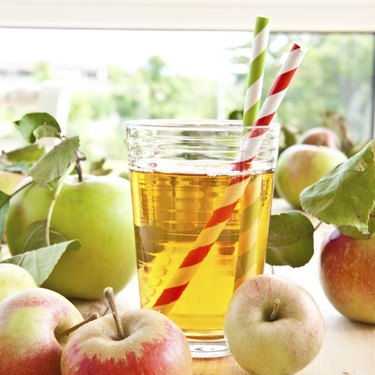
Allergy results when your body mistakenly attacks a molecule, most commonly a protein, present in food. This triggers a production of specific antibodies that recognize and eliminate the food proteins. As a result, your immune cells produce histamines and other chemicals that cause the typical symptoms of allergic reaction. Some apple juices can trigger an allergic reaction, even when you are not allergic to apples.
Apple Juice
Video of the Day
Apple juices can differ considerably in the ingredients they contain. Besides apples or apple juice concentrate, many juice producers add other ingredients, such as natural and artificial flavors, to their juices. If you are not allergic to apples but get a reaction when drinking an apple juice, you most likely are allergic to one of the added ingredients. Natural flavors can be made with wheat -- or soy -- based products. These two are common food allergens.
Video of the Day
Wheat and Soy Allergy
If you are allergic to wheat or soy, you can get an allergic reaction when eating foods that contain these ingredients or their proteins, such as some apple juices. Symptoms of wheat or soy allergy include skin reactions such as hives, swelling or redness; tingling of the mouth; swelling of the lips, tongue, face or throat; stomach cramps; and diarrhea. In severe cases, you can have an anaphylactic reaction associated with a loss of consciousness, difficulty breathing and severe drop in blood pressure. Anaphylaxis can be fatal unless treated quickly with an epinephrine injection.
Onset
Both soy and wheat allergies are common in young children that have immature immune and digestive systems. Children often outgrow their food allergies when their digestive systems mature and are less likely to absorb food components that trigger allergies. However, if a food allergy continues into adulthood, or develops during adulthood, the allergy is likely to remain for life, according to the National Institute of Allergy and Infectious Diseases.
Prevention
If you have a food allergy, the only way to prevent a reaction is to avoid the food entirely. Always check the food label for all the ingredients before buying a product. If you are allergic to wheat, avoid anything that lists wheat, natural flavoring, gluten, gelatinized or vegetable starch, or hydrolyzed vegetable protein as an ingredient. If you are allergic to soy, avoid foods that have soy protein; textured vegetable protein; hydrolyzed plant, vegetable or soy protein; natural or artificial flavoring; lecithin; or vegetable gum, starch or oil. When choosing an apple juice, pick one that is made from 100 percent apple juice concentrate and contains only water and ascorbic acid – vitamin C – as additional ingredients.
Allergy Testing
If you believe you have a food allergy, speak to your doctor about testing. A food allergy test can be as simple as eliminating the suspected food until your symptoms go away, then reintroducing it in your diet to see if symptoms return. Often, reintroducing a suspected allergen into your diet requires the supervision and direction of your health care provider, according to the National Institute of Allergy and Infectious Diseases. Other testing methods include a skin prick test, where a small amount of the suspected food substance is placed under the skin's surface and your reaction is measured; and blood testing which looks for certain anti-bodies.
- Cleveland Clinic: Special Diets for Food Allergies
- Annals of Allergy, Asthma and Immunology: The Natural History of Wheat Allergy
- MedlinePlus: Food Allergy
- The Consumerist: Snapple Tells Me Why Snapple Apple Juice Drink Doesn't Have Apples in Ingredients List
- National Institute of Allergy and Infectious Diseases: Food Allergy
- National Institute of Allergy and Infectious Diseases: Common Food Allergies in Infants, Children and Adults